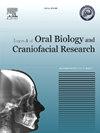舌孔锥束计算机断层扫描:回顾性影像学研究
Q1 Medicine
Journal of oral biology and craniofacial research
Pub Date : 2025-03-29
DOI:10.1016/j.jobcr.2025.03.015
引用次数: 0
摘要
牙科医生普遍认为,颏孔之间的下颌骨部位是最安全的手术部位,但有许多报道称,该区域发生了严重的出血事故。在进行植体植入和隆脊手术前,对舌前孔形态的存在和变化有充分的了解是必要的。目的分析舌孔与下颌骨下缘在锥形束计算机断层扫描(Cone Beam Computed Tomography, CBCT)上的存在、出现频率、位置及其关系。背景和设计本回顾性放射学研究是在马哈拉施特拉邦牙科科学研究所设计和实施的。经机构伦理委员会批准后,在印度拉图尔牙周病科进行研究。材料与方法随机获取100张全牙和部分无牙下颌骨的CBCT扫描,并对其冠状面、矢状面、横切面和横切面进行评估。在15 × 5 cm, 200 μm体素大小的视场下对患者进行诊断目的的CBCT扫描>;20和<;年龄均在70岁以上,男女不限。排除囊肿、肿瘤、影响骨骼的全身性疾病、骨折、椎间孔区既往手术和CBCT扫描质量差。记录孔的总数、孔的位置及其与下颌骨下缘的垂直距离。使用统计分析将数据输入数据表,并使用描述性和推断性统计进行分析。定性资料用比例表示,定量资料用均值和标准差表示。用卡方检验评估潜在显著性。结果随机分析100例CBCT扫描,其中男性47例,女性53例。所有参与者至少有1个舌孔(LF)。100次CBCT扫描共检测到172例LF,其中内侧LF (MLF) 154例(89.5%),外侧LF (LLF) 18例(10.4%)。在154例MLF中,63.6%表现为优结节,36.4%表现为劣结节。在100名受试者中,单个LF患者44例,43例2例,11例3例,1例4例,1例5例。94.44%发生在犬齿和第一前磨牙区。下颌下缘距上下颌赘骨的平均距离为10.87±2.99 mm,中下颌赘骨距上下颌赘骨的平均距离为7.1±4.76 mm。约三分之一的椎间孔位于距下缘13.1 ~ 16mm之间。结论考虑到本研究的局限性,舌中线孔可视为正常规律的解剖特征,其发生率为99%,而舌外侧孔发生率低,数量多变性大,常见于犬第一前磨牙区。近1/3的中线孔位于和风结节之上。本文章由计算机程序翻译,如有差异,请以英文原文为准。

Lingual foramina on cone beam computed tomography: A retrospective radiographic study
Context
Dental surgeons commonly believed that the mandibular site between the mental foramina is the safest for surgical procedures, but there have been numerous reports of significant bleeding accidents in this area. Adequate knowledge about the presence and variation in the morphology of anterior lingual foramina is necessary before starting surgical procedures such as implant placement and ridge augmentation.
Aim
The aim of this study was to analyse the presence, frequency, location and relationship of lingual foramen with the inferior border of mandible on Cone Beam Computed Tomography scans (CBCT).
Settings and design
This retrospective radiographic study was designed and conducted at Maharashtra Institute of Dental Sciences & Research, Latur, India in the Department of Periodontology after approval from the Institutional Ethical Committee.
Materials and methods
100 CBCT scans of dentulous and partially edentulous mandible were randomly acquired and assessed in coronal, sagittal, transverse and cross-sectional views. The CBCT scans made for diagnostic purposes under field of view 15 × 5 cm, 200 μm voxel size, of patients >20 and < 70 years of age of both the genders were included. Presence of cysts, tumours, systemic diseases affecting bone, fractures, previous surgery in the inter-foraminal region and poor quality of CBCT scans were excluded. Total number of foramina, their location and vertical distance between them to inferior border of mandible were recorded.
Statistical analysis used
Data were entered in data sheets and analysed by using descriptive and inferential statistics. Qualitative data were expressed in terms of proportions while quantitative data were expressed in terms of means and standard deviation. Potential significance was evaluated with Chi square tests.
Result
100 CBCT scans (47 male and 53 females) were randomly analysed. All participants had at least 1 lingual foramen (LF). Total 172 LF were detected on 100 CBCT scans, including 154 (89.5 %) medial LF (MLF) and 18 lateral LF (LLF) (10.4 %). Out of 154 MLF, 63.6 % were present superior and 36.4 % inferior to genial tubercles. Out of 100 subjects, single LF in 44, two in 43, three in 11, four in 1 and five in 1 patient were observed. 94.44 % LLF were observed in canine and 1st premolar region. The mean distance from the MLF and inferior border of mandible was 10.87 ± 2.99 mm, while the same for LLF was 7.1 ± 4.76 mm. About one third of the foramina were in between 13.1 and 16 mm distance from inferior border.
Conclusion
Considering the limitations of the study, the midline lingual foramen can be considered as normal regular anatomic feature with 99 % prevalence while the lateral lingual foramina occur infrequently with a lot of variability in numbers and present commonly in the canine-first premolar zone. Almost 1/3rd of midline foramina are present superior to the genial tubercles.
求助全文
通过发布文献求助,成功后即可免费获取论文全文。
去求助
来源期刊

Journal of oral biology and craniofacial research
Medicine-Otorhinolaryngology
CiteScore
4.90
自引率
0.00%
发文量
133
审稿时长
167 days
期刊介绍:
Journal of Oral Biology and Craniofacial Research (JOBCR)is the official journal of the Craniofacial Research Foundation (CRF). The journal aims to provide a common platform for both clinical and translational research and to promote interdisciplinary sciences in craniofacial region. JOBCR publishes content that includes diseases, injuries and defects in the head, neck, face, jaws and the hard and soft tissues of the mouth and jaws and face region; diagnosis and medical management of diseases specific to the orofacial tissues and of oral manifestations of systemic diseases; studies on identifying populations at risk of oral disease or in need of specific care, and comparing regional, environmental, social, and access similarities and differences in dental care between populations; diseases of the mouth and related structures like salivary glands, temporomandibular joints, facial muscles and perioral skin; biomedical engineering, tissue engineering and stem cells. The journal publishes reviews, commentaries, peer-reviewed original research articles, short communication, and case reports.
 求助内容:
求助内容: 应助结果提醒方式:
应助结果提醒方式:


